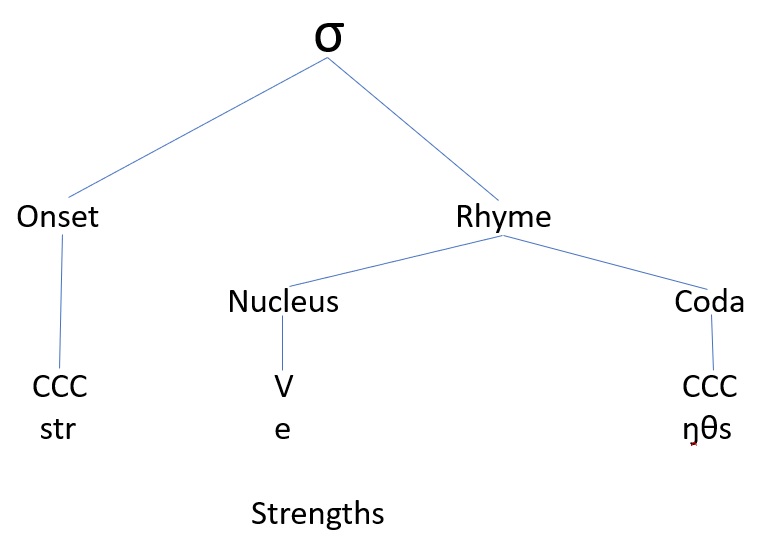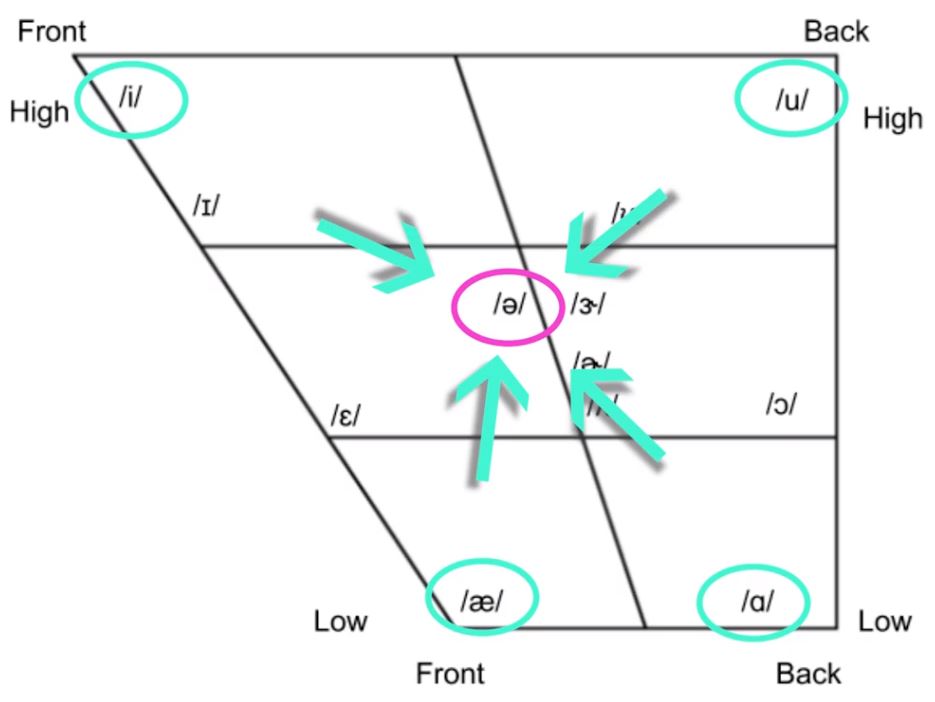3 Chapter 3 – Syllable Stress in Words
INTRODUCTION
In this chapter, readers will learn about syllable stress in words. By the end of the chapter, readers will be able to…
- explain the structure of a syllable
- distinguish between stressed-timed languages like English and syllable timed-languages such as Mandarin Chinese and Spanish
- notice three kinds of syllable stress in English words: primary, secondary, and unstressed syllables
- learn rules for stressing the correct syllable in words
- produce words and phrases with a variety of syllable stress
WHAT IS A SYLLABLE?
Individual speech sounds organize into groups or syllables. So, we can think of syllables as a unit of speech.
Syllables have an organization or structure. All syllables have a vowel or a vowel-like consonant. For example, the word kitten has two syllables. The first syllable has the high front lax vowel [ι] and the second syllable has a vowel-like or syllabic consonant, which is indicated by a dot under the [ņ].
kitten
[kι – Ɂņ]
Syllables can have consonants before and after the vowel. Consonants before the vowel form the onset of the syllable. In the word kitten, the velar stop [k] comes before the first vowel and the glottal stop [Ɂ] comes before the syllabic consonant [ņ] acting as a vowel.
The vowel and following consonants form a unit that is called the rhyme. The rhyme can be divided into a vowel or nucleus of a syllable and a coda, which is made up of consonants that follow the vowel nucleus.
In the diagram below, σ stands for “syllable.” The capital letters C and V stand for “consonant” and “vowel.”
This is the syllable structure for the word strengths, which is pronounced as [strɛŋθs].

Some speakers pronounce the word strengths with four consonants in the coda. The pronunciation looks like this [strɛŋgθs]. In his video, Andy McMillin pronounces the word with four consonants in the coda. Watch Andy McMillin’s video to hear this pronunciation and review the structure of the syllable.
STRESS-TIMED LANGUAGES AND THREE KINDS OF SYLLABLE STRESS
English is a stress-timed language, which means that the syllables in English vary in length, loudness, and vowel quality. This is in contrast to syllable-timed languages, which have syllables that do not vary as much as English syllables.
There are three kinds of syllable stress in English: primary stressed syllables, secondary stressed syllables, and unstressed syllables. Primary stressed syllables are louder and longer than the other syllables in the word. Unstressed syllables are reduced and short. Vowels that carry secondary stress are not as long or loud as the primary stressed vowels and not as reduced as an unstressed vowel.
By using the different syllable types, a kind of rhythm emerges. This rhythm is characteristic of North American English speech.
This video from Learn American English introduces the difference between stress-timed languages and syllable-timed timed language. Most of the video is about the three kind of syllable stress.
A three-syllable word with all three kinds of stress is understand.
un + der + stand
[secondary stress] + [unstressed] + [primary stress]
When you watch the video, look for the stress patterns of these words and notice how the pronunciation changes in the last syllable of the word estimate. If the last syllable carries primary or secondary stress (verb), then the syllable is not reduced. If the last syllable is unstressed (noun), then the syllable is reduced.
- estimate (verb)
- ‘ɛs-tə-ˌmeιt
- estimate (noun)
- ‘ɛs-tə-mιt
- absolutely (adverb)
- ˌæb-sə-‘lut-li
DETERMINING THE STRESSED SYLLABLE IN WORDS
English has complex word stress. There are rules and also exceptions. Here are three techniques for learning to stress the correct syllable.
- Listen for stressed syllables
- Use online dictionaries
- Apply rules for word Stress
The best way to acquire syllable stress is to be aware of the different kinds of stress. As you listen to other speakers, use online dictionaries and apply rules, your speech will start to change.
Listening for Stressed Syllables
One way to determine which vowels are stressed is to listen for stress in the speech of native speakers. Click on the words below to hear the stressed syllable. Listen for the primary stress in the words listed below. The first line gives the word. The next two lines show the syllable stress pattern.
Photograph
PHO-to-graph
[primary stress] + [unstressed] + [secondary stress]
Photographer
pho-TO-gra-pher
[unstressed] + [primary] + [unstressed] + [unstressed]
Photographical
Pho-to-GRAPH-i-cal
[secondary stress] + [unstressed] + [primary stress] + [unstressed] + [unstressed]
Online Dictionaries
A quick way to determine stressed and unstressed syllables is to use an online dictionary such as Dictionary.com or Merriam-Webster. The pronunciation for these words come from Merriam-Webster.
Dictionaries use their own versions of the International Phonetic Alphabet or other system to represent pronunciation in writing. You may want to learn the system of your favorite online dictionary. Here is an example from Merriam-Webster for the word economics.
ˌe – kə -ˈnä – miks

The lower line at the beginning of the word signals secondary stress. The raised line before the syllable [na] represents primary stress and the two dots or umlaut over the [a] simply refers to the [a] sound.
Listen to the pronunciation of this word and related words from Merriam-Webster dictionary. Notice that the stress pattern changes.
Rules for Syllable/Word Stress
There are many rules for syllable stress. The main point is that syllable stress is related to grammar. Some grammar categories that affect syllable stress are: nouns, suffixes, verbs, compound nouns, and suffixes.
Rules for Syllable Stress in Words
- The Two-Syllable Noun Rule with exceptions
- Suffix Rules
- The Compound Noun Rule
- The Two-Syllable Noun-Verb Rule
This short video from After School English gives some examples of these rules. The Suffix Rules are more complicated because English has many suffixes. Additional examples of the Suffix Rules are given below.
The Two-Syllable Noun Rule: The first syllable is stressed in most two-syllable nouns. There are a few exceptions.
Stress on First Syllable:
- JACket
- WINter
- HUman
- MOney
- APple
Exceptions:
- poLICE
- rePORT
- efFECT
- toDAY
Suffix Rules: Some suffixes are stressed and other suffixes move the stress one or two syllables to the left of the word.
- Stress the suffix for words ending in: -ee, -ette, eer, -ese.
- employEE
- cigarETTE
- volunTEER
- JapanESE
- Stress the syllable before suffixes for words ending in: “-cian,”-“tion,” “-sion,” “-ic,” and “-ical.”
- elecTRIcian
- preCIsion
- radiAtion
- motiVAtion
- eLECtric
- eLECtrical
- probleMAtic
- probleMAtical
- meTHODical
- heREtical
3. Stress two syllables before suffixes such as “-ate,” “-ary,” and “-ize.“
- COMpensate
- coORdinate
- VoCAbulary
- SEcretary
- EMphasize
- iDEalize
Exceptions include docuMENTary and CHARacterize.
The Two-Syllable Noun/Verb Rule: In nouns, the first syllable has primary stress and the second syllable is unstressed. In verbs, the first syllable is unstressed and the second syllable has primary stress.
- the REcord
- to reCORD
- an INsult
- to inSULT
- a PREsent
- to preSENT
The Compound Noun Rule: Compound nouns are two words that are put together, such as: “thunder” + “storm” = “thunderstorm.” In the examples below, the first syllable in the first word has primary stress and the first syllable in the second word has secondary stress. We can see this in the example for “thunderstorm.” The first syllable of the first word is THUN, which has primary stress. The first syllable of the second word is STORM, which has secondary stress. The syllable “der” is unstressed. So, the stress pattern is:
thun + der + storm
[primary stress] + [unstressed] + [secondary stress]
These examples from the video have PRIMARY stress on the first syllable of the word and secondary stress on the first syllable of the second word in the compound.
- SCHOOLboy
- TREEhouse
- PLAYground
- BLACKboard
- NOTEbook
- BACKpack
- DAtabase
UNSTRESSED SYLLABLES AND WORD REDUCTIONS
Unstressed syllables are important because they contribute to the rhythm of spoken English. They are also important because the vowel in unstressed syllables is reduced to a schwa or [ə], which is neither a high nor low vowel. It is neither a front nor back vowel. It is a mid, central vowel.
An example from the video Learn the American Accent uses the word banana to illustrate unstressed syllables. This word has two unstressed syllables, the first syllable and the last one.
The pronunciation of the word looks like [bə-næ-nə]. The unstressed syllables, [bə] and [nə], are shorter than the stressed syllable and pronounced with less volume. The stress pattern is:
[bə-næ-nə]
[unstressed syllable] + [stressed syllable] + [unstressed syllable]
Unstressed Syllables
The sound of a vowel can change depending on whether the vowel is in a stressed or unstressed syllable. Specifically, the high vowels [i] and [u] and the low vowels [æ] and [a] can change to a schwa when they are in unstressed syllables. Consider this image from the video Learn the American Accent on unstressed syllables.
Vowel in Unstressed Syllables

Example “object”
An example of the low back vowel [a] reducing to a schwa is in the word “object.” As a noun, the first syllable is stressed and sounds like [AB-jekt]. When the word is used as a verb, however, the stress moves to the second syllable. The first syllable of the verb is unstressed and sounds like a schwa [əb-JEKT].
Word Reductions
In speech, function words are typically reduced. Function words are prepositions, pronouns, helping verbs, articles, and conjunctions. Near the end of this video, the speaker illustrates word reduction with the preposition “for,” the pronouns “it” and “your”, the helping verbs “can” and “are,” and the prepositions “to” and “at.”
Consider these sentences:
- I bought this for you.
- I can do it.
- What are you doing?
- This is your book.
- We’re meeting at noon.
SYLLABLE STRESS IN WORD FAMILIES
A good place to hear syllable stress is in word families. Word families are groups of words that share the same stem but have different suffixes and/or prefixes. The examples below are academic words that come from a list compiled by Avril Coxhead to create an Academic Wordlist. Notice how the suffixes affect the syllable stress in the words.
Listen to the family of words related to CONCEPT. Notice the first syllable is stressed and pronounced as [kan-] when there are no suffixes. When the suffixes are added, the stressed syllable changes and the first syllable is reduced to [kən-].
- CONcept
- conCEPtual
- conceptualiZAtion
- conCEPtualize
Here are more examples.
- disTRIbute
- disTRIbuting
- distriBUtion
- redistriBUtion
- speCIfic
- specifiCAtion
- speciFIcity
- eCOnomy
- ecoNOmics
- eCOnomist
- ecoNOmical
- unecoNOmical
- iDENtify
- identifiCAtion
- identiFIable
- iDENtity
- unidentiFIable

